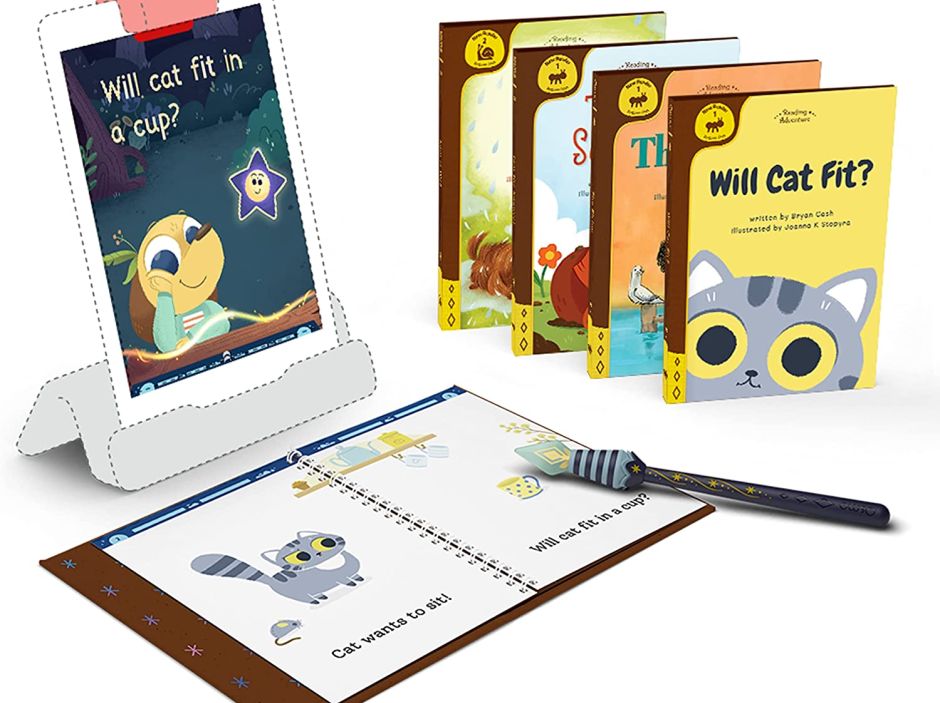Osmo Reading Adventure
Since its inception, Osmo has developed apps that creatively blur the line between learning and play. Where most of what we used to call Edutainment Software tended to look like electronic workbooks, most of Osmo’s have brought unique, creative approaches to integrate technology and learning in a manner that goes beyond the typical “drill and kill” approach of dittos and worksheets. In doing so, Osmo makes fosters independent thinking and makes it more likely that children will seek out their activities, thinking them truly entertaining and challenging (which they are, at the same time being excellent supplements to the in-school learning experience). Initially there are three levels available for purchase, one for “new”, “early”, and “emergent” readers. The Osmo website has an on-line wizard to help you determine which package is right for your child.
Unlike previous Osmo products buying the initial Osmo Reading Adventure offering is meant to be only the start, as the company envisions parents subscribing to the series, with new books delivered every month. In this way the series can level-up as your child progresses. One thing I’ve seen with Osmo is that once a child feels they have mastered the software it sometimes get put to the side, its novelty value having run its course. The subscription model, with regularly refreshed reading material, might go a long way in keeping a child engaged. Of course, this will depend on the quality of the books and whether new games are introduced to the mix. The subscription is $25 a month.
What’s in the box?
Four books specially encoded to work with the Osmo system come with the initial package, plus a stylus in the form of a magic wand. The software is downloadable for no additional cost. Of course, you must have a compatible iPad or Fire tablet, and the Osmo base (sold separately, or bundled).
I was sent the “new reader” set, designed to work with select iPads and Amazon Fire devices. To its credit each book credits its author and illustrator. Over the years I’ve found that learning systems that do not .often have inferior books, thinking that the content is the least important part of the package. Although two of the authors appear to be new, one Marylin Sadler has had many of her books published previously by Random House.
Two of the books feature main characters who are girls and two who are animals. Neither have boy characters. Two of the books have minority main characters, three if you count redheads. First primers are not known for their literary value. Yet, each book in the set has a bit of humor and a subtle sense of artistry reinforced by the illustrations.
Getting ready to read
Setting up the set is relatively easy, though I had to fiddle with the correct height of the red mirror device to get it to be able to see the books properly. Unlike many other electronic reading books, these do not necessarily start you off reading the books.
The program uses a back-story about catching “dreams” and returning them to slumber-land. Reading games and book reads are used to reinforce reading skills.
There are some basic games to get your child acclimated to the voice recognition software and other game mechanics. Sometimes the books are read to the child, other times the child reads them. On other occasions the directed activity takes you to one of the phonics games in the back pages of the book.
Interestingly, the program doesn’t correct every time the child makes a mistake. A note to parents at the first time the game starts explains that this is expected behavior. You should be prepared, however, to hear the game move forward in many, but not all cases, without giving an approbation or other recognition of the error.
The software seems to be less “forgiving” once a child enters one of the games in the back of the books. There, credit is not usually give for incorrect answers.
The activities include sight words and letter-sound recognition, and phonics and blending, among others.
The game makes certain assumptions about your child’s ability to read. The books and activities are primarily designed to supplement and give opportunities to review rather than be first introductions to reading. For the most part the voice recognition worked well so long as the game is not played in a noisy setting. However, on some occasions I disagreed with the “correct” answer that the game was looking for. Our tester was asked to match the “aw” sound (as pronounced by the iPad) to a word on the page that contained that sound. The closest match, and what turned out to be the correct answer, was “hot”. Now, if you come from certain parts of Brooklyn, particularly if you grew up in the ‘40s, that might be a match, but not today for most readers. Fortunately, this sort of problem was infrequently encountered.
Although the game does not read each book with a child before launching into the activities, I think it would be a good idea to do just that, to make sure your child is ready for the challenge. What you don’t want to do is set the child up for a frustrating experience that is beyond their reading level.
Conclusion
Osmo’s Reading Adventure rounds out the early school year’s curriculum line-up that started with math games last year. I am dubious that your child needs a monthly subscription of nearly fifty books in this series, but a judicious sampling will provide good practice and reinforcement of school learning without being “dry”. There is a place on the bookshelf for this Reading Adventure, particularly when used in conjunction with reading to (and with) a parent.



